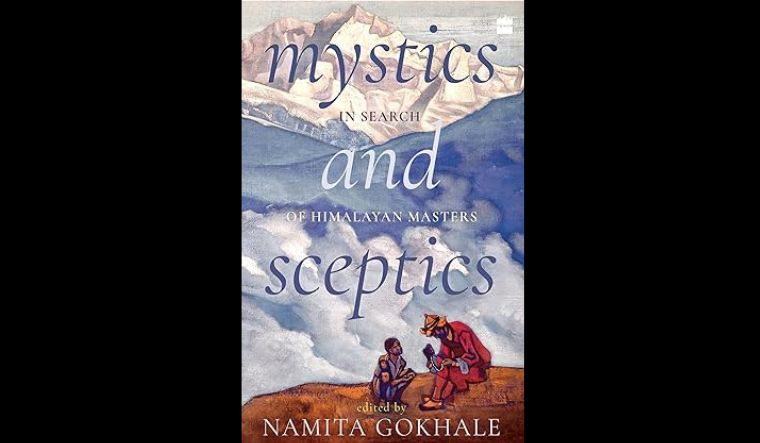They shrunk in Agha Shahid Ali's poetry. “The half inch Himalayas’’ turned Ali’s home Kashmir into a neat four by six inches in his poem. Historian John Keay trekked through these blue bruised mountains in his new monumental book, Himalayas, offering glimpse of its flora and fauna and history. And now Namita Gokhale has expanded them adding another dimension—one rarely explored—essential to their myth in Mystics and Sceptics—in search of Himalayan Masters.
Mystics and Sceptics—in search of Himalayan Masters is an anthology of 25 essays and is the best kind, a landscape of spiritual that is as diverse as the Himalayas—and crammed with different traditions. And it comes at a time when this journey across the Himalayas is most needed. The book has been translated into Hindi and will be out in a new avatar later this year.
Mystics and Sceptics is as much about masters as about faith, fate, fakir and in a way, fakiri. There are many who find their way into the book—Guru Nanak, Yeshe Tsogyal, a consort of Guru Padmasambhava who as Holly Gayley writes in her essay “she is not just an active figure from a distant past, she remains an active and enduring presence’’, Lal Ded, Swami Vivekanada, Neem Kalori Baba who inspired Mark Zukerberg and Steve Jobs, Paramhansa Yogananda and the Dalai Lama. What binds these essays is, as Gokhale writes, that they “carry the spirit of the seeker of the search and the continuing journey’’ . But more than just intellectual connection the real meaning between these 25 essays goes deeper.
The accounts are fascinating, and the chroniclers too. Rene Von Nebesky-Wojkowitz—a Czech ethnologist and Tibetolgist—who died at 36 writes a fascinating account of witnessing a Tibetan trance. His own life is similarly fascinating. His early death is believed to have been caused by the “wrath of the protective deities whose esoteric and mystic secrets he had presumed to write about,’’ writes Gokhale. Rene writes about the Mighty Thunderbolt entering the body of an oracle priest, Lhangpa Tondup. This usually does not happen in front of a foreigner, so he is very lucky. Vividly described, the essay offers a ringside view into the trance. “His face turned red, and once again assumed the terrible demonic expression I knew from the first trance,’’ he writes. At the end of the ceremony, the priest’s clothes were soaked with sweat and staggered out of the room supported by two men. The trance, as he writes later, is induced with a little help from hashish and red pepper.
If Rene’s essay is about a faith and spirited leaps into it, Swami Rama’s essay on The Sage from the Valley of Flowers about his encounter with Gudari Baba is control of mind. Swami Rama, is himself a seeker.
As Swami Rama follows Gudari Baba to the Valley of Flowers, he is asked to carry his blanket. “I agreed, but when I put the blanket on my shoulders, I stumbled under its weight,’’ he writes. What follows is his journey to the Valley of Flowers he is disoriented with the fragrance of the flowers. And Baba tells him, “Your joy was because of the influence of the fragrance of the flowers. You were no meditating. That’s what marijuana and hashish do to peoole and they think they are in meditation,’’ writes Swami Rama.
“The education given to modern children is very superficial,’’ he says. “Without any discipline, control over the mind is not possible—and without control of mind, direct experience is impossible.”
But what makes the book so haunting is that it is personal for Gokhale and comes from her own journey. “I am personally both a mystic and a sceptic, reluctant to yield any rationality,’’ in her essay on Neem Karoli Baba and Siddha Ma. And this is a theme that is explored beyond just her essay. But more than just about the existing between both these polar opposites, the book is also a testimony to faith and devotion. It is also about wisdom.
“Sometimes people say faith is the opposite of doubt, but I don’t think that is true,’’ Gokhale quotes Larry Brilliant, who worked at the World Health Organisation and played an important role in eradicating small pox from his book, Sometimes Brilliant, as saying. “To me, the opposite of faith certainty. Doubt is the true companion of true faith; like God, it is more verb than noun. Faith is the ride, not the station as Indians describe it.”
Gokhale is offering her reader a ride to this journey. If you jump it, you will never return the same.
Title: Mystics and Sceptics—in search of Himalayan Masters
Edited by Namita Gokhale
Publisher: Harper Collins India
Pages: 326
Price: Rs 699



